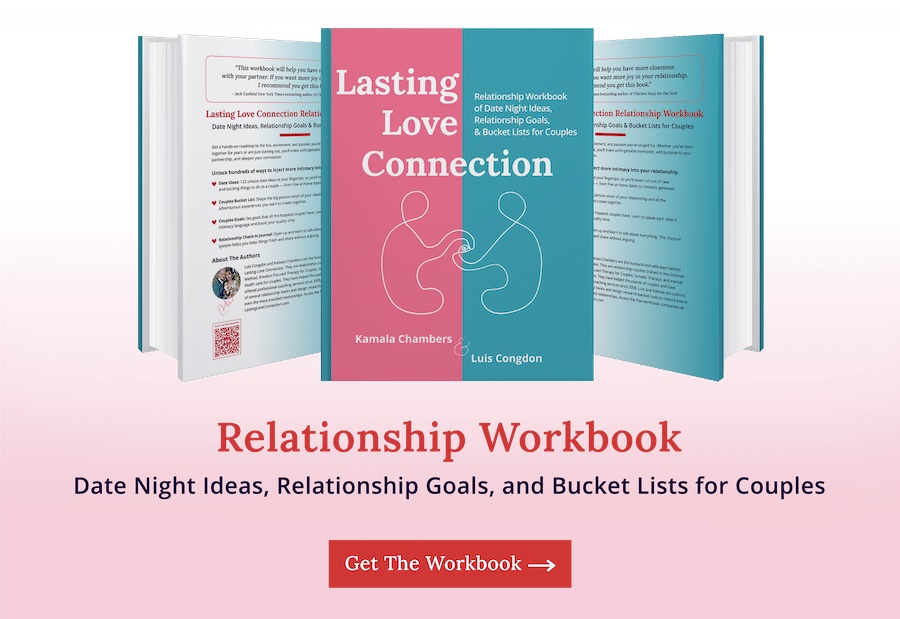Are you looking for couples therapy exercises to bridge the communication gap?
Do you want to develop skills to bring you closer?
If so, wonderful. We’ve got you covered.
Couples communication is about two things.
First, communication is about what you say.
Second, communication is about what your partner HEARS.
What you mean to say doesn’t always match what your partner hears – that’s where problems begin.
Maybe you’ve experienced this dilemma.
You say something with good intentions, and suddenly, your partner reacts and gets upset.
You start talking over each other, trying to explain yourselves to no avail.
This clashing communication pattern will repeat until what you say and what your partner hears align.
Ultimately, the key to communication is feeling heard and understood.
Couples therapy exercises will help you improve communication.
Table of Contents
The benefits of relationship communication exercises

Learning to communicate effectively takes time, particularly if you and your partner are stuck in poor communication habits.
However, it is possible to develop new ways of relating to each other, so you fight less often, resolve conflict sooner, and stay on track.
As you practice couples communication exercises, you’ll:
- Break out of toxic communication patterns.
- Start building a foundation of honest communication.
- Practice compassionate listening to deepen empathy and understanding.
- Learn new strategies for overcoming communication problems.
Couples Therapy Communication Exercises
Typically, the following communication exercises and trust-building exercises are methods you’ll learn in couples coaching.
These healthy communication exercises will help you enhance your communication skills, strengthen your relationship, and deepen intimacy.
You can work through these communication exercises together at home or with the support of a mental health professional – like a licensed professional counselor or couples coach.
To learn more about how you and your partner can implement these skills, book a complimentary consultation.
1. Active listening

Perhaps you feel unheard when your attempts to share your emotions with your partner are dismissed.
Instead of empathizing, your partner offers solutions or changes the subject entirely.
However, what you truly desire is not to be fixed but listened to and understood.
You long for your partner to recognize the validity of your feelings and reassure you you’re not alone in experiencing them.
To start building healthy marriage communication with each other, practice active listening skills.
Active listening allows you and your partner to share whatever’s on your mind without fear of being interrupted or dismissed.
To practice active listening, set a timer for 5 minutes and have one partner start talking about anything–work, the kids, the relationship, whatever it might be.
During this time, the listening partner can demonstrate interest through nonverbal cues (like eye contact, facial expressions, and open body language).
After 5 minutes, they can ask follow-up questions to ensure they understood what you said or prompt you to share further.
Then, switch partners and listen attentively as your partner speaks.
Listening to each other without interrupting is one of the simplest couple communication exercises for building trust and intimacy.
If you’d like to learn more, here’s an active listening video that we enjoy and recommend.
2. Reflective listening

Although your partner appears engaged in conversations, you might still feel misunderstood.
As a result, you’re left feeling lonely and burdened by your own thoughts and fears.
If you are experiencing this pattern, try a simple reflective listening mirroring exercise.
Take a few minutes to share what’s on your mind.
Then, your partner can respond with ‘What I’m hearing is…’ and paraphrase what you shared in their own words.
It’s okay if they’re not exactly right.
However, this allows you to see how you’re being heard.
That way, you can clarify what you are trying to convey and ensure that your main points are not lost in translation.
Reflective listening helps you to stay engaged in conversations and increases understanding.
Additionally, this is one of the most powerful communication exercises for couples longing to feel heard and understood.
3. 40-20-40 exercise

This couples communication exercise for couples involves both partners getting an equal opportunity to express their feelings – 40% each and 20% reserved for discussing the relationship.
For instance, you may want to communicate to your partner how it makes you feel when they are constantly on their phone during your time together.
During the first part of the conversation, one partner speaks without interruption or defensiveness from the other. The second part of the conversation allows the other partner sharing to express their emotions.
The goal is to listen and understand each other’s perspectives without getting into a circular argument.
Finally, both partners should work together to resolve the conflict in the remaining time.
4. Use ‘I’ statements

Using I statements is one of the most effective communication exercises for couples looking to shift how they talk to each other.
When we’re frustrated or angry, it can be easy to make it about what our partner is doing (or not doing.)
‘You always roll your eyes at me.’
‘You never want to spend time with me.’
Using words like always or never can make your partner feel like they’re being attacked or blamed.
As a result, they’re more likely to shut down instead of being receptive to your concerns.
Instead, try using ‘I’ statements.
Using an ‘I’ statement such as ‘I feel hurt when…’ or ‘I feel unseen when…’ keeps the focus on your feelings instead of blaming your partner.
According to research by Dr. John and Julie Gottman, using ‘I’ statements leads to gentle start-ups and better conflict resolution.
This communication exercise helps you express yourself clearly and respectfully- in a way your partner is more likely to be receptive to.
5. State a positive need

Sometimes, when we try to communicate our needs, it can be interpreted as criticism.
For instance, you may feel frustrated because your partner leaves the room every time you mention a particular topic.
It can be tempting to say something like, “You’re so immature! You always walk away when I’m talking!”
However, this approach is likely to make your partner defensive and less willing to discuss the issue.
Instead, try to identify the underlying need behind your complaint and express it in a positive way.
For example, you could say something like, “I want us to be able to discuss this calmly. Can we talk about what you need to feel more comfortable during these conversations?”
Expressing your needs positively and respectfully is one of the best assertive communication exercises to strengthen your relationship.
6. Ask meaningful questions

When you’ve settled into comfortable routines with your partner, it’s easy for conversations to be solely about logistics and responsibilities.
It can be disheartening to realize that a week has gone by, and all you’ve discussed is what’s for dinner and who’s picking up the kids.
However, there’s a simple way to break out of this pattern: ask meaningful questions.
It can be as simple as, “What’s on your mind today?” Or more specific, like, “How do you feel about the project you’re working on?”
By initiating these meaningful conversations, we show our partners that we’re interested in getting to know them on a deeper level.
Ultimately, asking questions is one of the most effective communication exercises for deepening understanding, trust, and intimacy between romantic partners.
Related Reading: Over 50 Premarital Counseling Questions
7. Relationship check-ins

Relationship check-ins are one of the best communication exercises for couples who want to stop sweeping relationship problems under the rug.
When you have relationship check-ins regularly, you can address minor concerns as they come up instead of letting them fester and become bigger problems.
Set aside time each week to check in with your partner and discuss how things are going in your relationship.
During your relationship check-in, you can ask questions like:
- What were the highs/lows from your week?
- What are you anxious about this week?
- Are there any unresolved conflicts or issues we need to address?
- Are your needs getting met in our relationship?
- How did I make you feel most loved this week?
- How can I support you in the week to come?
As your partner shares, listen attentively without interrupting or responding defensively.
Ultimately, relationship check-ins allow you and your partner to talk about anything without fear of judgment or criticism.
For a step-by-step guide to relationship check-ins and a year-long journal to fill out together, pick up the Relationship Workbook.

8. Name 3 things…

One of the simplest couple communication exercises to improve communication is the “name 3 things” exercise.
To start, choose a theme such as “Name 3 things you appreciate about your partner” or “Name 3 things you want to do together this month.”
One partner can share, followed by the other partner. Or take turns sharing one thing at a time.
This exercise provides an opportunity to learn more about each other, express appreciation, and explore new topics of conversation.
9. Sandwich method

When you make your favorite sandwich, you sandwich the meat (or peanut butter) in the middle of two slices of bread.
Think of requesting something from your partner in the same way.
Instead of coming to them with a need (which can come off as demanding), sandwich your ask between two positive statements.
For example, “It was so helpful of you to make dinner last night when I had to work late. Would it be possible for you to cook again on Thursday when I have another late meeting at work? I appreciate your support lately.”
The Sandwich Method is an effective communication exercise because approaching your partner with positivity and gratitude will make your partner much more receptive to your request.
10. Share a story

Sharing stories is a great way to practice expressing your emotions and empathizing with your partner’s feelings.
Your story could be a happy memory, a challenging real-life experience, or a significant moment from your relationship.
Try to be as descriptive as possible and explain how the story affected you personally.
Once you’ve shared your story, your listening partner can reflect on the key points, how it made you feel, and the impact it had.
This communication exercise can help build intimacy as you open up and share your experiences.
11. Express gratitude

If you and your partner find yourselves constantly arguing or feeling disconnected, it is natural to focus on the negative aspects of your relationship.
However, shifting your focus to what your partner is doing right can make a significant difference.
Expressing gratitude shifts your mindset towards your partner and spurs positive feelings in the relationship.
Studies show that expressing gratitude with your partner can even produce oxytocin, a hormone associated with bonding.
To practice expressing gratitude, you can:
- Tell your partner a positive quality you appreciate about them.
- Share 3 things you love about your relationship.
- Plan a special date night your partner will enjoy.
- Thank your partner for something they did this week.
- Play the appreciation game.
All of us can agree it feels wonderful to be appreciated, which can easily get lost in a relationship.
Making gratitude a regular exercise in your relationship can help you both interact in a more positive way.
12. Stress-reducing conversation

Relationship expert Dr. John Gottman created the stress-reducing conversation as a way for couples to discuss stressors and deepen emotional intimacy.
The only condition is that stressors concerning the relationship should not be discussed.
You can share your work-related frustrations, concerns about a friend or family member, or any upcoming event that is causing you stress.
If you’re unsure where to start, use these questions to get the conversation going:
- What is causing you the most stress right now?
- How do you experience stress in your body?
- What helps you to relieve stress?
As your partner shares about their stressors, listen without interrupting.
Only give them advice or solutions if they specifically ask for them. Instead, use nonverbal communication cues to demonstrate interest.
Maintain eye contact and open body language.
Validate your partner’s emotions, even if you see the situation differently.
This communication exercise allows you and your partner the space to feel heard and supported.
Additionally, it lowers your partner’s stress levels.
This exercise reminds you that your partner is on your side and you’re a team.
Gottman found that couples who engaged in regular stress-reducing conversations felt closer to each other and more supported in their relationships.
13. Switch roles

This communication exercise illuminates how your partner experiences your communication style.
Start by choosing a topic, such as plans for the upcoming weekend or a situation that might cause conflict.
Communicate as your partner during the conversation, and they will respond as they believe you would.
As you do this exercise, you’ll uncover blind spots in how you communicate and gain more insight into how you can get on the same page.
14. Eye gazing

You don’t always need words to connect deeply and powerfully.
When you practice eye gazing, you tune into your partner’s feelings through facial expressions.
To do this nonverbal communication exercise, sit facing each other and look deeply into each other’s eyes.
Try to keep your gaze on your partner for five minutes.
Various studies have shown that eye gazing enhances trust and intimacy with your partner.
Additionally, stopping to see your partner can make a huge difference in your relationship.
15. Discuss triggers

Do you notice any repeated patterns in your fights?
There are likely specific triggers that almost always lead to an argument.
It could be when your partner approaches you in a way that seems accusatory or uses a harsh tone.
Sit down with your partner and discuss a recent argument you had.
Share what caused you to get worked up or shut down.
What did your partner do that made you angry or upset?
As you discuss your triggers, you’ll better understand each other’s behavior and why you react in certain ways.
Moreover, you can adjust your behavior to avoid triggering your partner.
This couples therapy exercise is most effective in a couples counseling session. Book a free couples consult to discuss working together.
16. 90-second rule

You’re talking to your partner, and things are getting heated.
You can feel your breath becoming constricted and your heart starting to pound.
In the heat of the moment, the 90-second rule allows you to pause instead of reacting immediately and saying something you don’t mean.
Count down from 90 slowly while taking deep breaths.
If you’re still outside your window of tolerance after 90 seconds, ask your partner to take a 20-minute break before you return to the conversation.
That way, you can return to the conversation once you’re calm and continue the discussion in a productive manner.
17. Reframe past statements

Reframing painful words is one of the most powerful marriage communication exercises for couples healing from past hurts.
First, you and your partner should list 3 statements or words that have stuck with you from a previous fight.
Next, take turns sharing why those words impacted you the way you did.
Lastly, work together to rewrite those statements more respectfully.
This reframing exercise is one of those relationship communication exercises that also engages your written communication skills. !
18. Explore love languages

Our love language is the way that we prefer to receive love.
There are five love languages– words of affirmation, quality time, acts of service, receiving gifts, and physical touch.
If you and your partner haven’t learned to speak each other’s love language, your efforts to connect could be missing the mark.
For example, if you need your words of affirmation to feel loved in romantic relationships, and your partner shows love by helping with practical tasks– you’re likely to experience hurt feelings and disappointment.
Discovering your love languages and talking about what helps you feel loved allows you to show up for each other in the ways that matter most.
Discover your love languages in the Relationship Workbook.
19. Create a shared vision board
A shared vision board is a fun at-home date night activity that spurs conversation about what you want for your relationship.
Start by planning a time to sit down and discuss your goals and dreams.
What do you want your life together to look like?
What experiences do you want to share?
And what do you want to accomplish together?
What’s on your bucket list?
Next, browse magazines and Internet sources and choose pictures that reflect your couple goals and dreams.
Work together to arrange them on a piece of paper or cardboard or inside the Relationship Workbook, and add other decorations if you’d like.

Improve your communication skills in couples therapy
If you and your partner still find yourselves stuck in negative communication habits that are taking a toll on your relationship, seek support from mental health professionals.
Working with a mental health professional (like a couples therapist or coach) provides a safe space for navigating relationship problems and developing the tools for effective communication.
Further, a trained expert provides guidance as you practice communication exercises.
Additionally, a great coach will show you trust-building exercises to enhance your relationship.
If you need help building healthy relationships, we’re here for you.
Book a complimentary consultation with us today.
Exploring the types of communication
Interpersonal communication describes the exchange of information between two or more people.
There are various types of interpersonal communication, including:
- Written communication
- Verbal communication
- Nonverbal communication
- Listening
All of the above are ways we express ourselves and receive messages from others.
Feel free to play around with the different types of communication, so you can explore new ways of connecting.
Developing an assertive communication style
There are three basic communication styles:
- Passive communication is when you don’t voice your own feelings or needs.
- Aggressive communication is characterized by criticizing, attacking, or intimidating others.
- Assertive communication is when you express your feelings, opinions, and needs clearly and respectfully.
Out of the communication styles, you want to strive for assertive communication.
That way, you clearly share your needs and feelings without blaming your partner and sparking an argument.
What are good communication skills in a romantic relationship?
Communication skills are defined by a couple’s ability to hear each other, understand each other, and feel emotionally connected. A healthy relationship involves communicating calmly and respectfully. One of the best ways to do this is to manage the escalation during heated conversations. When you use these couples therapy exercises, we guarantee that you and your partner will get along better and feel more heard and understood by each other.
What are some communication exercises for couples?
Several effective couples communication exercises like active listening, “I” statements, non-violent communication, and exploring nonverbal cues promote healthier communication patterns and create a more fulfilling relationship.
To learn how to apply these skills in couples therapy, book a complimentary couples consult.






0 Comments